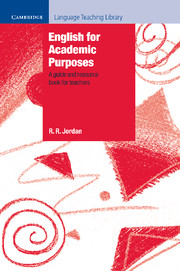Book contents
- Frontmatter
- Contents
- List of figures
- List of abbreviations
- Acknowledgements
- Introduction
- Part I English for Academic Purposes and study skills
- Part II Study skills and practice (EGAP)
- Part III English for Specific Academic Purposes
- Appendices
- 1 Recommended books and journals
- 2 Educational technology
- 3 BALEAP, and the Survey
- 4 EAP exams and examining bodies
- References
- Subject index
- Author index
4 - EAP exams and examining bodies
Published online by Cambridge University Press: 10 November 2010
- Frontmatter
- Contents
- List of figures
- List of abbreviations
- Acknowledgements
- Introduction
- Part I English for Academic Purposes and study skills
- Part II Study skills and practice (EGAP)
- Part III English for Specific Academic Purposes
- Appendices
- 1 Recommended books and journals
- 2 Educational technology
- 3 BALEAP, and the Survey
- 4 EAP exams and examining bodies
- References
- Subject index
- Author index
Summary
The main public exams listed here are examples of proficiency tests (commented on in Chapter 5). The biggest, in terms of student numbers, are the IELTS test and TOEFL. They are used for admission purposes by universities and other academic institutions world-wide; increasingly, third-country training is provided for these two exams. NEAB's exam, UETESOL, is also used for admission to UK universities. (Two of the Cambridge Exams are also recognised for admission purposes in the UK, i.e. Certificate of Proficiency and Certificate in Advanced English.)
Full accounts of the above exams, and many others, and how they compare, are contained in Davies and West (1989), the best overall guide. There is also a useful survey of the same exams in Carroll and West (1989) and Simmonds (1985), and an appraisal of the TOEFL by Traynor (1985). Castillo (1990) describes the RELC Test of Proficiency in EAP, with which it is of interest to compare the above public exams.
A very clear and useful table of comparison between many of the exams is provided in the second edition of the English-Speaking Union's Framework chart – English Language Examinations from Britain (R. West and G. Walsh 1993). The Framework consists of a nine-level scale, with exams grouped according to the type of English tested: General, Business, Study, and Young Learners; the scale is reproduced below. The nine bands used by IELTS in its overall band scores are similar to these.
- Type
- Chapter
- Information
- English for Academic PurposesA Guide and Resource Book for Teachers, pp. 362 - 364Publisher: Cambridge University PressPrint publication year: 1997



